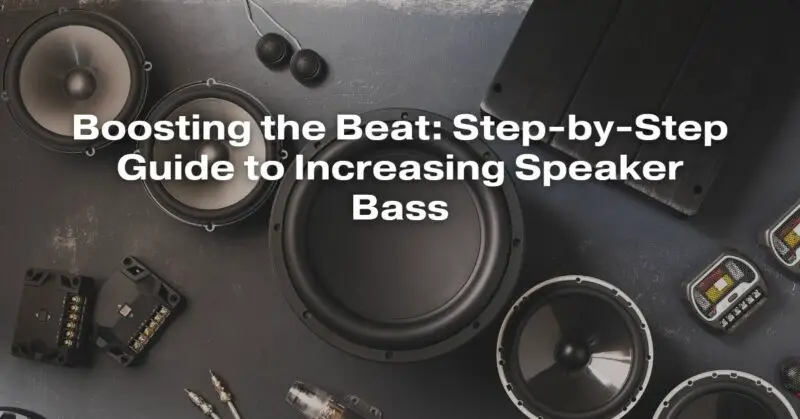Music is more than just sound; it’s an experience that can touch your soul and move your body. One critical element of this experience is the bass, that deep, resonant pulse that can make your heart race and your feet move. Whether you’re an audiophile, a musician, or just a casual music lover, enhancing the bass in your speakers can take your listening experience to the next level. In this comprehensive guide, we’ll walk you through the process of boosting the bass in your speakers, step by step.
Understanding the Bass
Before diving into the practical steps, it’s essential to understand what bass is and why it’s so important in music. Bass refers to the lower frequencies in a sound, typically ranging from about 20Hz to 250Hz or even lower. These frequencies are responsible for creating the foundation and groove of a song. Without adequate bass, music can feel thin and lackluster.
Step 1: Choose the Right Speakers
The foundation of great bass begins with the right speakers. When selecting speakers, consider the size, type, and power rating. Larger speakers tend to produce deeper bass, so if bass is your priority, opt for larger woofers. Subwoofers are specifically designed for reproducing low frequencies and can significantly enhance bass response. Also, ensure that your speakers can handle the power you plan to feed them, as inadequate power can lead to distortion.
Step 2: Optimize Speaker Placement
Where you place your speakers in a room can have a profound impact on bass response. Experiment with speaker placement by moving them closer to walls or corners, as this can amplify bass frequencies. However, be cautious not to place them too close, as it can lead to muddiness and overemphasis of certain frequencies. Consider investing in acoustic treatments like bass traps and diffusers to further optimize your room’s acoustics.
Step 3: Use an Equalizer
An equalizer (EQ) is a crucial tool for fine-tuning your speaker’s bass response. Most audio systems, including modern amplifiers and AV receivers, come with built-in EQ settings. Adjust the EQ to boost the lower frequencies while maintaining a balanced sound. Be cautious not to overdo it, as excessive bass boost can lead to distortion and an unnatural sound. A gradual increase in the low-frequency range is typically more effective.
Step 4: Invest in a Subwoofer
If you’re still craving more bass after optimizing your speakers and using EQ, it might be time to invest in a dedicated subwoofer. Subwoofers are designed specifically for reproducing low frequencies and can provide a significant bass boost to your audio system. When setting up a subwoofer, experiment with its placement in the room to find the optimal position for maximum bass impact.
Step 5: Upgrade Your Audio Source
The source of your music can also impact bass quality. High-quality audio files, such as FLAC or WAV, tend to have better bass definition than compressed formats like MP3. Additionally, upgrading your audio source, such as using a dedicated music player or a high-quality DAC (Digital-to-Analog Converter), can further enhance bass clarity and depth.
Step 6: Fine-Tune Your Subwoofer Settings
If you’ve added a subwoofer to your setup, it’s essential to fine-tune its settings. Subwoofers typically come with controls for adjusting parameters like volume, crossover frequency, and phase. Experiment with these settings to find the sweet spot that complements your speakers and room acoustics. Using a dedicated calibration tool or microphone can help ensure precise adjustments.
Step 7: Consider Bass Enhancement Technologies
Modern technology offers various tools and devices designed to enhance bass. Some AV receivers come with bass management systems and room correction software that can automatically optimize your audio for your specific room. Additionally, you can explore bass enhancement devices and plugins that can be used in conjunction with your audio source or amplifier to further boost bass performance.
Step 8: Be Mindful of Distortion
While increasing bass can be exhilarating, it’s crucial to be mindful of distortion. Overloading your speakers or subwoofer with excessive bass can lead to distortion, which not only ruins the listening experience but can also damage your equipment. Always monitor the volume levels and bass settings to avoid pushing your speakers beyond their limits.
Step 9: Test and Adjust
The process of boosting the bass in your speakers is not a one-size-fits-all solution. It requires experimentation and fine-tuning. Take the time to listen to various types of music and adjust your settings accordingly. Trust your ears, and don’t be afraid to make small adjustments until you achieve the desired bass response.
Step 10: Enjoy the Enhanced Bass Experience
With your speakers optimized, EQ settings dialed in, and potentially a subwoofer added to the mix, it’s time to sit back and enjoy the enhanced bass experience. Crank up your favorite tunes, and let the deep, pulsating bass transport you into the heart of the music.
In conclusion, boosting the bass in your speakers is a rewarding journey that can elevate your music listening experience to new heights. By choosing the right speakers, optimizing their placement, using EQ, considering a subwoofer, upgrading your audio source, fine-tuning settings, and being mindful of distortion, you can achieve a balanced and powerful bass response that enhances the enjoyment of your favorite music. Remember that patience and experimentation are key, and ultimately, the goal is to immerse yourself in the rich, rhythmic world of bass-infused sound.


